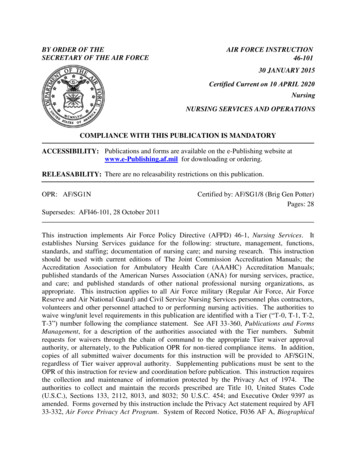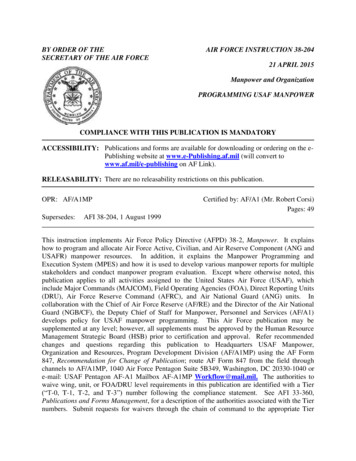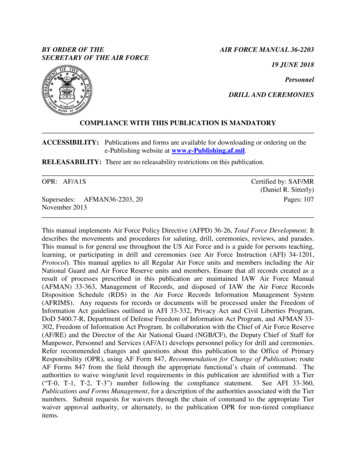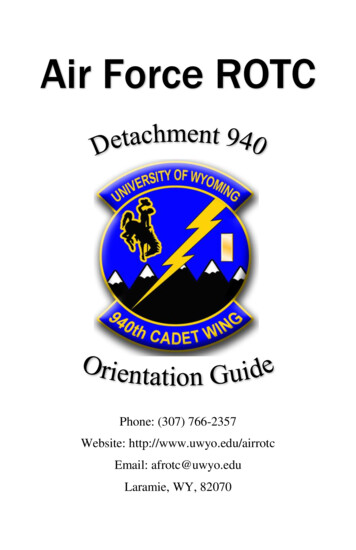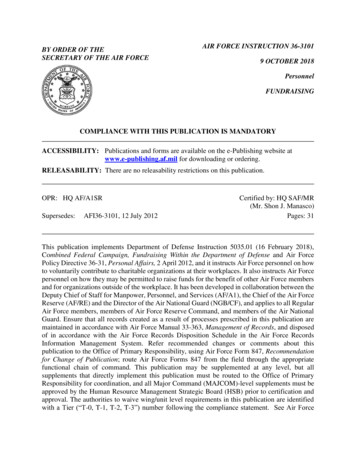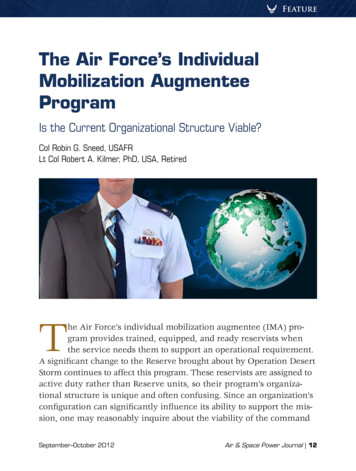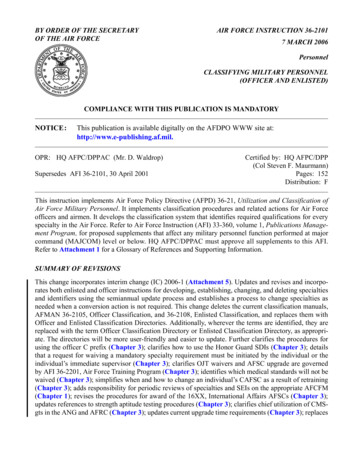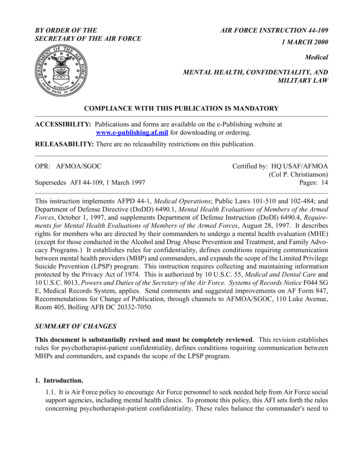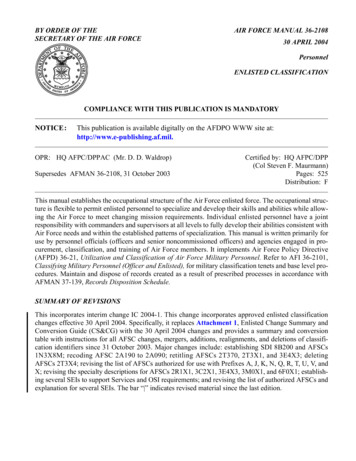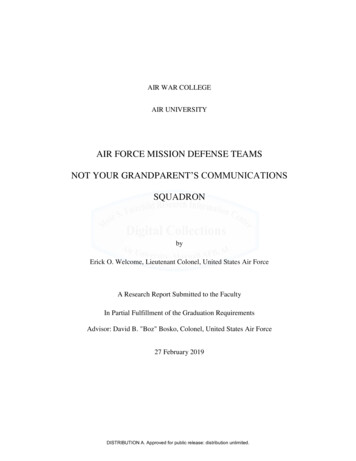
Transcription
AIR WAR COLLEGEAIR UNIVERSITYAIR FORCE MISSION DEFENSE TEAMSNOT YOUR GRANDPARENT’S COMMUNICATIONSSQUADRONbyErick O. Welcome, Lieutenant Colonel, United States Air ForceA Research Report Submitted to the FacultyIn Partial Fulfillment of the Graduation RequirementsAdvisor: David B. "Boz" Bosko, Colonel, United States Air Force27 February 2019DISTRIBUTION A. Approved for public release: distribution unlimited.
DISCLAIMERThe views expressed in this academic research paper are those of the author and do notreflect the official policy or position of the US government, the Department of Defense, or AirUniversity. In accordance with Air Force Instruction 51-303, it is not copyrighted but is theproperty of the United States government.ii
BiographyLieutenant Colonel Erick O. Welcome is currently a student at the Air War College, AirUniversity, Maxwell Air Force Base, Alabama. He entered the Air Force in 1990 as a graduateof Basic Military Training. After serving 10 years as an enlisted professional he later graduatedfrom Southern Illinois University and received his commission from Officer Training School in2000. He is a cyber operations officer who has served at the squadron, group, major command,and Joint Staff levels. This includes commanding the 451st Expeditionary CommunicationsSquadron at Kandahar Airfield, Afghanistan, and the 460th Space Communications Squadron atBuckley AFB, Colorado. He attended Intermediate Developmental Education at the UnitedStates Army’s Command and General Staff College at Fort Leavenworth, Kansas. LieutenantColonel Welcome holds a Bachelor of Science Degree in Industrial Technology from SouthernIllinois University at Carbondale and a Master of Management-International Studies degreefrom the University of Phoenix.iii
AbstractAir Force core mission areas are vulnerable to nefarious cyber activities and senior AirForce leadership has impressed upon the Air Force to rapidly strengthen organic defensivecyber operations at the base level. Adversaries have proven to deny, degrade and disrupt AirForce weapon systems that enable (1) air and space superiority; (2) intelligence, surveillance,and reconnaissance; (3) rapid global mobility; (4) global strike; and (5) command and control.What organic defensive cyber capability do base level communications unit have to guaranteemission assurance? This paper examines the effectiveness of Air Force Mission Defense Teams(MDT) that are designed to deliver mission assurance through base-level proactive andpersistent defensive cyber operations. Through research, surveyed various in-garrison anddeployed units that have employed MDTs and interpret their effectiveness based on thefollowing areas; intelligence, tools, training and talent management. Will makerecommendations to strengthen MDTs based on research, interviews, surveys and overallfeedback from the field. Finally, the Air Force cannot afford to have gaps in defending weaponsystems from nefarious cyber activities at the base level. Mission Defense Teams must have arobust cyber defense arsenal to enable the Air Force ability to achieve core missions.Former U.S. President Obama indicated cyber-security among greatest challenges.“Just as we're all connected like never before, we have to work together like neverbefore, both to seize opportunities but also meet the challenges of this information age.It's is one of the great paradoxes of our time that the very technologies that empower usto do great good can also be used to undermine us and inflict great harm.”Barak Obama, former President, United States of America1iv
IntroductionThe United States Air Force lacks mature cyber Mission Defense Teams that are capableto effectively defend nefarious cyber activities that target Air Force weapon systems. Air Forceweapon systems consist of aircraft, ground-based, space and missile defense systems which areheavily reliant on complex software and high interconnectedly to perform their missions.2Cyber capabilities enable several sophisticated features (e.g., electronic warfare, precisionstrikes, and communications) that allow the Air Force to have a competitive advantage overadversaries, but creates opportunities for adversaries to counter these advantages throughcyberattacks.3Adversaries that compose of nation states or a potential lone wolf actor constantlyattempts to discover and exploit vulnerabilities in a satellite’s ground station software,supporting systems or logistics systems in order to obtain intelligence or to disrupt or degradeoperations. Air Force base-level communications squadron have historically providedtraditional information technology services to include: unclassified and classified voice and datacapabilities, Radar, Airfield and Weather Systems capabilities that support an operational wing.In order to better understand the Mission Defense Team construct, this paper willattempt to answer the question, “Has Air Force Mission Defense Teams met Air ForceRequirements?” The goal of this paper is to 1) describe the pre-MDT state; 2) describe thedesired MDT state; and then 3) provide recommendations to solve the gap between items 1 and2 regarding MDT construct, intelligence support, training, talent and tools, and authorities. So,how did the Mission Defense Team effort start?
Pre-Mission Defense Team PosturePre-Mission Defense Team: Business RulesBase or installation communications units in the past have generally focused onproviding traditional information technology services to base users with a limited focus onmission assurance of weapon systems. These units were organized, trained and equipped toprovided general services such as Non-classified Internet Protocol Router Network (NIPRNet),Secret Internet Protocol Router Network (SIPRNet), client services, basic voice and datacapabilities and in some cases Radar, Airfield and Weather Systems (RAWS), formerly AirTraffic Control and Landing Systems (ATCALS). This communications culture cultivated anoperation focused on network management and keeping “comms” green without clearlyunderstanding how information technology affected operations. Additionally, communicationssquadrons are typically aligned under a Mission Support Group in a standard wing structure.4Table 1. Air Force Typical Traditional Wing Structure per AFI 38-1015Communications squadrons aligned under a Mission Support Group have typicallyfocused on supporting the base’s information technology requirements without strictly focusingon the core mission or providing proactive cyber defenses. This communications posture2
created a mindset focused on network management and keeping “comms” green without clearlyunderstanding how information technology affected mission assurance or enabled operations.This business practice evolved into how communications units have been operationally limitedbased on a lack of intelligence, cyber tools, training and talent to effectively defend the weaponsystem and guarantee mission assurance.Pre-Mission Defense Team: Lack of Cyber IntelligenceBased on the creation of Air Force Network Operations Squadrons in 2007 base levelcommunications units relied on these new organizations to provide as close to real-timeintelligence to respond to nefarious cyber activities or vulnerabilities across the Air Forceenterprise. However, vulnerabilities were not disseminated real-time, but more so on ascheduled basis to allow base units to apply patches and other remediation efforts to mitigate orremove vulnerabilities.The impact of not having an organic intelligent capability to inform cyber defensetactics, techniques and procedures actions have proven to be costly and impacted operations.Per Major General Patrick Higby, former Director of Air Force cyber strategy and policy, mostcommunications units did not understand how information technology affected day-to-daymission operations. General Higby eluded “when a circuit went out or a server crashed or aradio net went down, if a comm squadron commander went to their wing commander and saidthey just lost circuit x, y or z, the wing commander would ask what that meant for the mission;oftentimes the communications squadron commander did not have the full understanding ofhow communications affected operations.”63
Pre-Mission Defense Team: Lack of Cyber Defense ToolsCommunications squadrons are aligned under cybersecurity service providers and lack arobust suite of tools to perform cyber defense actions at the base level. The Air Force createdthis environment based on the Cyber Security and Control System (CSCS) weapon system.This weapon system was designed to provide 24/7 network operations and managementfunctions and enable key enterprise services within Air Force unclassified and classifiednetworks while providing defensive operations within those Air Force networks.7The CSCS was an initiative to save resources, but more so focused on centralizedcommand and control and less decentralized execution as several bases did not have tools toeffectively operate, maintain and defend their base networks. In an effort to save money andmanpower, a wing’s cyber defense posture was limited to defensive cyber operationscapabilities at the base level.Local communications units focused on defending unclassified and classified voice anddata networks that supported the base mission, but not necessarily an installation’s weaponsystem. For example, a space wing may have a missile warning mission that is fueled by aparticular weapon system where the local communications have no situational awareness of itsdefensive cyber operations posture. Additionally, there were not any organic cyber defensetools local units were authorized to use on the weapon system.Weapon systems have no-fail mission networks that are isolated from a base’s generalservice networks. These networks are not easily cleared to test defensive cyber operations toolsdue to the complexity of the weapon systems and lack of key cyber terrain knowledge. Inaddition to a lack of tools, there is a huge cybersecurity training gap of the MDT cyberworkforce.4
Pre-Mission Defense Team: Lack of Cyber Security TrainingThe majority of Airmen in the cyberspace support Career field (3DXXX) do nothave the resident expertise to defend base networks as their training pipeline is designed tofocus on managing information technology services supporting generic base missions. There isa major cyber defense training gap that prevents teams from focusing on providing missionassurance of Air Force weapon systems. Per the Air Force Career Field Education and TrainingPlan for Cyberspace Support, Airmen are charged to perform system analysis and design,programming, systems operation and maintenance, resource management and security management.In addition, these cyber Airmen execute activities for installing, maintaining, repairing, overhauling,deploying, and modifying cyberspace systems and equipment platforms. Finally, they conductnetwork warfare operations in garrison and at deployed locations by performing duties to develop,sustain, and enhance network and electromagnetic capabilities to defend national interests fromattack and to create effects in the cyberspace domain to achieve national objectives.8 There is aclear lack of defensive cyber operations training to educate base-level personnel to effectivelydefense base and weapon systems.Table 2. 3DXXX Career Field Path – No Codified Defensive Cyber Operations Path95
Pre-Mission Defense Team: Lack of Cyber Security TalentAs discussed earlier, the majority of cyber support Airmen assigned to a typical wing areorganized, trained and equipped to provide traditional information technology support and arenot organized to defend base weapon systems. There is no dedicated defensive cyber operationsforce allocated specifically for base communications units. Airmen within the Air ForceCyberspace Defensive Operations (1B4X1) air force specialty code is designed to performduties to develop, sustain, and enhance cyberspace capabilities to defend national interests fromattack and to create effects in cyberspace to achieve national objectives.10 Unfortunately, thishigh-demand, low-density asset is prioritized to support the Air Force’s contribution to CyberMission Forces.The Cyber Mission Force is United States Cyber Command’s action arm, and teamsexecute the command’s mission to direct, synchronize and coordinate cyberspace operations indefense of the nation’s interests.11 These teams are critical to the nation’s defense byidentifying and blocking adversary activities and maneuvering to defeat adversaries. Whilethese missions are critical, several cyber-savvy Airmen have been allocated to support thismission.The Air Force has roughly 2,500 cyber officers on active duty and those 2,500 officersmust fill cyber mission force requirements, as well as Air Force cybersecurity requirements.12When it comes to retention rates in the Air Force, the cyber mission force is manned at 100percent, meaning the 39 Air Force teams dedicated to USCYBERCOM will receive 100 percentof their staffing.13 Additionally, there is a high demand for cyber professionals within thecommercial sector and the Air Force has invested in and lost several cyber Airmen toopportunities in the civilian workforce.6
The Department of Defense (DoD) faces tremendous challenges in recruiting andretaining trained and experienced cybersecurity professionals.14 DoD’s challenge is part of alarger worldwide shortfall for this high demand resource. According to the Global InformationSecurity Workforce Study, cybersecurity professionals’ manpower shortfall is on track to reach1.8 million by 2022.15 It is a fact that DoD pay lags behind the commercial industry – annualbase pay for an E5 with four years of service is 32,000 and an O-3 with four years of service is 66,300 – based on the 2018 pay scale.16 In contrast, the average civilian cyber penetrationtester with four years of experience earns approximately 115,00017; DoD has an uphill battle tocompete with industry. Retention will continue to be a key component hindering the Air Forcefrom having a talented cyber workforce and achieving the desired state of full mission capableMission Defense Teams.Feedback from Strategic, Operational and Tactical LevelsFeedback from the Field: Not all MDTs Meeting Air Force RequirementsThere is no better way of understanding how the Air Force Mission Defense Teams arepostured without engaging the teams who are in the field accomplishing this important mission.As such, I reached out to various key players at the strategic, operational and tactical levels tobetter answer the question: “Are Air Force Mission Defense Teams meeting Air ForceRequirements”? The overwhelming response is “not quite”; however, there are a few MDTsthat are further along than others, but until the organizational culture shifts, MDTs will belimited in maximizing their effectiveness.7
Feedback from the Field: Need to Change CultureThe old paradigm of base-level communications squadrons only being a service providerfor an installation and not focusing on defending weapon systems is no longer. Per MajorGeneral Robert J. Skinner, Commander, 24th Air Force; Commander, Air Forces Cyber andCommander, Joint Force Headquarters-Cyber, “it all starts with changing the culture beyond ashadow of a doubt. Wing commanders and the entire wing structure must not only embrace andadvocate for the MDT mission but also heavily invest in people and equipment to re-orientacceptance of this wing capability.”18 The successful MDTs have full support from their wingand group leadership, which allows units to take risks in other mission areas and focus onproviding mission assurance of weapon systems. Currently, the AF IT workforce is tied tooperations and sustainment of commodities and services limiting its ability to field an agilecyberspace workforce.19 A key driver of advocating for a change of culture is for wing leadersto better understand their installation’s cyber defense posture of their weapon systems through aFunctional Mission Analysis (FMA).An FMA identifies a wing’s core mission’s key cyber terrain and provides amethodology to analyze the unit’s operational mission to understand how cyberspace systemscontribute to mission success and how cyber vulnerabilities translate to mission risk. 20 Keyterrain in cyberspace is found across traditional information systems, control systems,platforms, and weapon systems.21 Most importantly, by understanding risks to core missionsenables senior leaders to make informed decisions about the health of their networks andprovides greater credibility to investing in Mission Defense Teams. The realization of cripplinga wing’s core mission due to a cyber incident provides base communication squadrons thejustification they need for senior leaders to change the culture of a service-oriented environment8
to one of mission assurance of weapon systems. Another gap preventing the fielding of aneffective MDT is a lack of organic manpower. Good news is the implementation of theEnterprise Information Technology as a Service (EITaaS) initiative will enable units to providemanning for their MDTs.Feedback from The Field: Must Provide Units with MDT Organic ManpowerEnterprise Information Technology as a Service initiative will selectively leverage theprivate sector to provide standardized, innovative, and agile IT services to the AF through theuse of worldwide commercial business services and best practices.22 This new approach willenable the utilization of the AF IT workforce to the cyberspace workforce.23 The EITaaSinitiative is a transformational effort that will free up a unit’s military and civilian personnel toresource MDTs. Based on feedback from the field, units are still responsible of providing ITservices across a particular base and must take risks in certain mission areas to allocatemanpower towards MDTs until contractors are in place to accept IT-service responsibilities.The more effective MDTs have aggressively moved out with hiring contractors to operate ontheir MDTs which is a plus as contractors are hired with the required skillset to effectivelyemploy cyber defense tactics, techniques and procedures. Hiring contractors will be based onwing leaders prioritizing wing requirements and investing dollars in the organization, trainingand equipping of MDTs to reach the desired state expeditiously.Mission Defense Team – Desired StateThe Mission Defense Team end state is to produce specialized cyber teams across theAir Force whose primary mission will be to defend local installations and critical mission tasksfrom nefarious cyber activities.24 This effort will take heavy investments by the Air Force inbase communications units to ensure they are organized, trained and equipped to increase their9
defensive cyber posture. Moreover, communicators will need to have an increasedfamiliarization with the base’s core mission.Major General Robert “Bob” Skinner, Air Forces Cyber Commander eluded that if awing has an F-16 unit that’s responsible for offensive counter air or defensive counter airsupport, mission defense teams will need to understand those weapon systems and everythingthat goes into making those air sorties successful as a way to defend that mission from a cyberstandpoint.25 The days of only focusing on maintaining 1s and 0s and not understanding howcomputer systems affect core missions are long gone. Similar to the integration of operationsand maintenance, cyber operators will need to spend countless hours understanding how thenetwork and internet of things affect operations. At the core of how MDTs are envisioned aresix desired effects; 1) Mission Assurance 2) Identification of Advanced Persistent Threats3) Mission Mapping to Identify Cyberspace Key Terrain 4) Localized Cyber Superiority 5)Persistent Monitoring and Characterization 6) Adversary EngagementTable 3. MDT Employment Operational View -12610
Mission Defense Team – Desired State: Mission AssuranceUltimately Mission Defense Teams will be charged to deliver mission assurance of AirForce weapon systems through laser-focused employment of weapon and mission systemdefense capabilities. Future vulnerabilities and threats will continue to heighten which calls forproactive MDT tactics, techniques and procedures to counter those threats. This effort causes arapid shift in focus from compliance and cybersecurity to a focus on cyber defense whileenabling core Air Force missions and capabilities.27 Additionally, intelligence will play acritical role in knowing what vulnerabilities are present or on the horizon and most importantly,how to respond to those threats.Mission Defense Team – Desired State: Identification of Advanced Persistent ThreatsIt is imperative that future Mission Defense Team operations are driven by intelligencethat is timely, accurate and actionable.28 In order for MDTs to be effective in their tactics,techniques and procedures an organic base level intelligence cell will need to be a part of theMDT construct. Higher echelon intelligence organizations will need to link MDTs within withthe Intelligence Community to not only inform mission planning but identify potential threats todefended systems.29Receiving intelligence of threats to mission systems and more importantly understandinghow weapon systems operate from a cyber lens is a critical piece to defending those weaponsystems. MDTs will need to have the capability to find, fix, track, target and engage advancedpersistent threats in the least amount of time possible. Mission Defense Teams will need toperform a Functional Mission Analysis and Network Characterization of weapon systems toidentify key cyber terrain and dependencies related to the wing’s operational missions. This11
effort will assist MDT personnel to not only detect but to respond to nefarious activities oranomalies within the weapon system.Mission Defense Team – Desired State: Mission Mapping to Identify Key Cyber TerrainTeams will need to understand what “right looks like” to be effective in defending AirForce weapon systems. At its pinnacle, defensive cyber operations “hunting” is the search forkey cyber terrain with a goal of understanding the link between cyber terrain and the mission itenables.30 MDTs will need to fully immerse into operations to have an intimate understandingof how systems and networks affect weapon systems and by performing a thorough FunctionalMission Analysis will provide the level of fidelity required.Mission Defense Team – Desired State: Localized Cyber SuperiorityMission Defense Teams need to ensure cyber superiority at their localized sites to ensuremission assurance of selected weapon systems. It is well known that military superiority in theair, land, sea, and space domains is critical to the United States ability to defend its interests andprotect United States values. Achieving superiority in the physical domains relies heavily oncyberspace; however, the United States military oftentimes risks yielding cyberspacesuperiority.31United States adversaries have exploited the speed, capacity of data and eventsin cyberspace, making the domain more hostile.Maintaining local cybersecurity in a hostile environment is not an easy task and will callfor an integrated partnership amongst base users. Cybersecurity is every user’s business and alack of cyber hygiene and discipline will cause grave effects to operations. In 2015 the JointStaff’s unclassified email was hacked by suspected Russian actors due to poor cybersecuritydiscipline.12
Per open source reporting, Joint staff personnel received spear-phishing emails that weremodified messages that appeared to originate from trusted associates. These emails containedembedded links to documents that caused malware to be downloaded on specific computersystems. This lack of user discipline prompted the Joint Staff to disconnect from the globalunclassified email system for 11 days.32 Maintaining cybersecurity of base networks will needa laser focus not only from Mission Defense Teams but also from every user accessing DoDinformation systems.Mission Defense Team – Desired State: Persistent Monitoring and CharacterizationMission Defense Teams will need to have the ability to persistently monitor, have theability to characterize nefarious cyber activities and enable base operations the option offighting through a cyber disruption or attack. The adversary gets a vote and will executevarious tactics, techniques and procedures to deny, disrupt, degrade, deceive and exploitmission system processing. Teams will need to understand how to leverage “Hunting” activitiesand techniques to integrate mission assurance and defensive cyber operations capabilities whiledefending key cyber terrain.33 Close integration with Computer Network Defense ServiceProviders will be critical to for MDTs to be effective with persistent monitoring andcharacterization of the network. Teams will need to be well-versed on defensive cyberoperations hunting through close integration with mission owners and understanding theirrespective cyber key terrain.Mission Defense Team – Desired State: Increase Organic ManpowerAs base communications squadrons transform into cyber squadrons, unit personnel willneed organic manpower focused on defending weapon systems and more importantly possessthe authorities required to process required cyber effects. Additionally, the integration of13
intelligence personnel within cyber squadrons is paramount to ensuring cyber squadrons areintelligence driven.34 Training will be a key enabler to ensure MDTs will have similar skills toCyber Protection Teams.Mission Defense Teams will need a codified training pipeline and continuous track toensure personnel are capable of effectively employing defensive cyber operations. PerAFCYBER Commander, Major General Bob Skinner, “The Mission Defense Team is a cyberprotection team “lite”, we are very proud of our cyber protection team training and the moretraining we can provide our MDTs, the more successful they will become. Then we can reallyfocus our cyber protection teams on greater threats that we will face with a peer competitor andpeer adversaries.”35Mission Defense Team – Desired State: Adversary EngagementOne of the key attributes Mission Defense Teams needs to possess is the ability to notonly engage adversaries but have the ability to defeat them without impacting operations. Thiseffort will require appropriate manpower, training, intelligence and a suite of cyber tools thatcan be tailored to specific cyber operations. Cyber operations must be codified into severalweapon system exercises to include red teaming to adequately posture MDTs to be ready whenadversary engagement is probable or imminent.During a 2018 wing exercise at Tyndall Air Force Base a Mission Defense Team wastested to validate protecting weapon systems in a dynamic security environment in whichpotentially unknown cyber vulnerabilities could impact operations. The exercise objective wasto assist the Air Force to create a process that would inform cyber analysts to determine if asoftware glitch inside an aircraft was an isolated failure or if other aircraft across the world wereexperiencing the same issue.36 This operational focus by Air Force communications units is a14
transformational shift of being a base information technology service provider to focusing onmission assurance.RecommendationsActions to Solve Gap between MDT Current and Desired End StateThe Air Force must prioritize Mission Defense Teams and invest in their overalldevelopment; specifically, intelligence, cyber tools, talent, and training. These four areas arecritical to closing the gap between MDT current and desired end state. Integration with theIntelligence Community to better understand potential threats and vulnerabilities is a criticalfirst piece to creating robust DCO teams. Per Colonel Dave Bosko, Air Force Cyber CollegeInstructor, “not only is cyber a consumer of intelligence, but cyber is also a producer ofintelligence artifacts.”37 In addition, there are several agencies and organizations that MDTscan leverage to maximize their utility. The Air Force Cyber College is a tremendous resourcethat offers units to various resources to strengthen their MDTs.The Air Force Cyber College located at Maxwell Air Force Base, Alabama createsconcepts, theory, strategies and force development for national cyber endeavors.38 Per ColBosko, “the leadership within the college is actively engaged with supporting MDTs by meetingwith wing leadership, providing functional mission analysis cyber training and partnering withthe Cyber Resilience Office of Weapon Systems”. Air Cyber College leaders have beeninstrumental in elevating the priority levels of support for MDTs.The Air Force Cyber College team met with several wing commanders to highlight theneed to defend weapon systems and hammer home vulnerabilities found within those systemsand potential operational impacts. The college is comprised of rated and non-rated seniorofficers and civilians from various backgrounds and experience. Through direct engagement15
with wing leaders, the college has helped squadron commanders with their MDT advocacy andresource challenges. These visits are complimented due to the Functional Mission Analysisperformed at each base to highlight key cyber terrain and cybersecurity strengths andweaknesses of weapon systems.In Fiscal Year 2018 the AF Cyber College administered Functional Mission AnalysisCyber (FMA-C) training to 650 personnel while supporting a total of 2,040 graduates. Inaddition, the college provided guidance and education to Air War College, Air Command andStaff College and Squadron Officer School students. The FMA-C course bridges the gapbetween network operations and the five core missions of the Air Force.39 Students learncritical and strategic thinking skills and apply them acco
particular weapon system where the local communications have no situational awareness of its defensive cyber operations posture. Additionally, there were not any organic cyber defense tools local units were authorized to use on the weapon system. Weapon systems have no-fail mission networks that are isolated from a base's general service .
